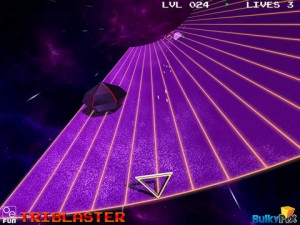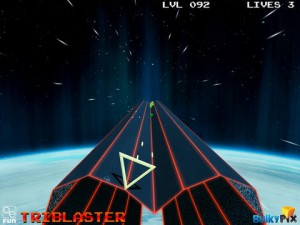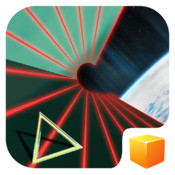In a dimension filled with geometric lines — simplistic looking three-dimensional shapes — and extremely functional user-friendly controls, one triangle shaped spaceship must fight to stay alive! Plot aside, the most obvious thing for someone to compare with BulkyPix’s TriBlaster (out now, $0.99) would probably be the original Tempest (at least assuming the person you’re asking is actually old enough to remember the aforementioned classic). While apps seeking to ape the function of earlier gaming gems are common place these days; TriBlaster not only stands up to Tempest’s legacy, but also brings something new to the table as well.
 For those of you whom have never before played Tempest — however — a more proper explanation of TriBlaster’s mechanics are probably in order, so let’s start off with that first. Each level features your triangular spaceship placed on one end of an effectively flat battlefield (even though they may sometimes be curved) wherein your must protect yourself from an advancing army of evil alien shapes. Players are then left to their own devices in order to see just how far — across 100 different levels — that they can survive the alien onslaught, as well as discover just how far they can push their personal high score.
For those of you whom have never before played Tempest — however — a more proper explanation of TriBlaster’s mechanics are probably in order, so let’s start off with that first. Each level features your triangular spaceship placed on one end of an effectively flat battlefield (even though they may sometimes be curved) wherein your must protect yourself from an advancing army of evil alien shapes. Players are then left to their own devices in order to see just how far — across 100 different levels — that they can survive the alien onslaught, as well as discover just how far they can push their personal high score.
To that end — much like most of the arcade games that it seeks to pay homage — TriBlaster comes equipped with a simple, yet robust, input scheme for managing your alien geometry blasting efforts. First off: putting your finger down upon the screen’s bottom left or right hand side, with the player freely permitted to choose either one, causes your ship to endlessly fire forward until the screen is released. Furthermore, sliding this same finger across the screen will doubly enable access to TriBlaster’s analog-joystick functionality (with the caveat being that your ship is always restricted to moving left and right only).
One the other side of the screen — opposite to whichever end is chosen for gun and motion control — are two additional buttons, Jump and Beam, both of which will draw from your spaceship’s energy pool whenever used. Whereas Tempest’s players were basically little more than dead men walking once an alien reached their end of the level, in TriBlaster you can still safely evade these foes by temporarily leaping up off of the very stage itself. Further aiding players here — should they ever find themselves in a bind — is the beam option, which enables your little ship to unleash large swaths of destruction (yet must be used sparingly due to its massive power consumption).
 The energy needed to power these two abilities are acquired via tiny green triangles that are dropped whenever any of the opposing alien spaceships, as well as the mysterious green space algae, get eradicated. As the jump and beam functions will become ever increasingly vital to a player’s survival as time marches forward, the acquisition — and management — of this precious resource will be paramount to a player’s survival. Thankfully players will never have to worry about rapidly collecting all of these energy units before a stage’s end, as no level in TriBlaster — even after all of the aliens are gone — will ever finish until after you have first scooped up all of the little triangles.
The energy needed to power these two abilities are acquired via tiny green triangles that are dropped whenever any of the opposing alien spaceships, as well as the mysterious green space algae, get eradicated. As the jump and beam functions will become ever increasingly vital to a player’s survival as time marches forward, the acquisition — and management — of this precious resource will be paramount to a player’s survival. Thankfully players will never have to worry about rapidly collecting all of these energy units before a stage’s end, as no level in TriBlaster — even after all of the aliens are gone — will ever finish until after you have first scooped up all of the little triangles.
Further keeping with this retro-tradition that TriBlaster aims to keep alive, the game exclusively features six different enemy types — as well as some recolored variants — for gamers to memorize and master. While some of these aliens will charge straight down a single lane until they have reached your end, and others still will jump and slide all over the battlefield, the most menacing of the lot will fire out complex bullet sprays as well. Player will also at times be tasked with tackling the ever growing space algae, whom — although not immediately lethal — will sap all of your triangle-ship’s energy should you ever touch a lane that they’ve fully consumed.
Anyways — game play matters aside — I am further happy to announce that TriBlaster not only functions as a skillfully updated classic, it even manages to look the part as well. Everything presented here is extremely true to the same visual design philosophies which drove the appearance of vector-graphics in the past, just now with a little more color and visual flare thrown on top. Furthermore, the fact that solid surfaces are now a practicality has even been cleverly utilized here to create challenges that were never before possible (such as curved stages where not all of the playing field can be observed simultaneously).
 What’s more, the game’s deliberately desired old school motif has gone well beyond merely featuring primitive 3D models — replete with positively jagged edges — managing instead to help shape other parts of TriBlaster’s design as well. For instance: the title screen — if you leave it running long enough — will eventually be replaced with an arcade style attract mode, afterwards followed by a point value listing of the various enemies. This old school flair is then further perpetuated by the addition of bonus stages, which Tempest itself never featured, wherein players may earn extra energy — or lives, if their energy gauge was already filled up — by grabbing a series of fast moving targets.
What’s more, the game’s deliberately desired old school motif has gone well beyond merely featuring primitive 3D models — replete with positively jagged edges — managing instead to help shape other parts of TriBlaster’s design as well. For instance: the title screen — if you leave it running long enough — will eventually be replaced with an arcade style attract mode, afterwards followed by a point value listing of the various enemies. This old school flair is then further perpetuated by the addition of bonus stages, which Tempest itself never featured, wherein players may earn extra energy — or lives, if their energy gauge was already filled up — by grabbing a series of fast moving targets.
In conclusion, if you were ever a fan of the original Tempest — or just happened to like old school style arcade games in general — then BulkyPix’s TriBlaster is definitely one game that I can wholeheartedly recommend.
iFanzine Verdict: While many games on the iTunes Marketplace have often attempted to ape the appearance and form of arcade classics, often with middling results, TriBlaster goes the full nine yards in replicating Tempest’s style. With solid controls — graphics that simultaneously feel both old and new — and some new game play elements added to the mix, TriBlaster is an excellent step forward upon the concept. For those of you whom ever loved Tempest — or just classical videogames in general — you certainly can’t go wrong with this one, even if it never was inside an actual arcade in the 80’s.


